
A shorter look at that controversial motion picture can be found in another of my articles, dated August 20, 2017, entitled "THE AMERICAN CIVIL WAR THROUGH THE EYES OF HOLLYWOOD". Which covers how Hollywood looked at both sides of that war from Griffith's 1915 "The Birth of a Nation" through director Nate Parker's 2016 motion picture. Also called "The Birth of a Nation".
That article can be found at:
http://www.bewaretheblog.com/2017/08/the-american-civil-war-through-eyes-of.html
A Short Biography
D.W. Griffth's father was Jacob Wark "Roaring Jake" Griffith. He was born in Virginia, October 13, 1819, and fought as a Union Officer during the Mexican-American war between 1846 and 1848. When Virginia succeeded from the Union, on April 17, 1861, Jacob Wark Griffith became a Lieutenant Colonel in the Confederate Army. When he returned to his home, after the war ended, Jacob found it located in the new State of West Virginia. Which had been pro-Union since that area succeeded from the larger State of Virginia, on June 30, 1863, and became, almost immediately, the 35th State of the United States.
Next, Lieutenant Colonel Griffith moved to Kentucky, became a member of that State's legislature, and married Mary Perkins Oglesby. She had been born in Oldham County, on December 19, 1829, and would become the mother of seven children. D.W., her youngest, was born on January 22, 1875. I give you this information, because the boy listened to war stories about the glory of the Confederacy until he was 10 years old and his father, the story teller, passed away.
Four years later David Wark's mother took her children from their failing farm to Louisville, Kentucky, and opened a boarding house. Which, like their farm, failed, and D.W. had to leave high school and begin working to help his family survive.
The young man became an actor with touring companies and attempted to become a playwright, but could not sell anything. In 1907, in New York City, D.W. Griffith was attempting to sell another of his plays. He made a fateful decision and went to the "The Edison Studios", owned by inventor Thomas Alva Edison, the creator of the American film industry. He couldn't sell his latest work, but producer Edwin S. Porter gave him an acting position in the 1908 motion picture "Rescued from an Eagle's Nest" and D.W. was on his way to working within the motion picture industry.
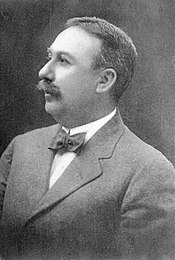
Above Edwin S, Porter
In 1908 he worked first for the "American Mutoscope Studio" and next the larger "Biograph Company". They hired D.W. as a stage extra, but again fate stepped in. On one of the Biograph sets Griffith met cameraman Billy Bitzer, below, and struck up a friendship. This led to meeting the co-founder of the studio Harry Marvin.
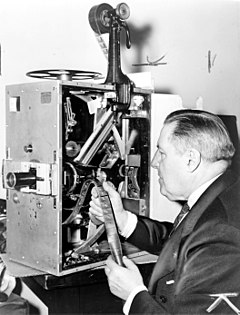
"Biograph's" main director, Wallace McCuthson, became very ill and his son took over, but was producing low standard motion pictures. Bitzer stepped in and recommended D.W. Griffith as a replacement and McCuthson, Jr., who had been fired, and Griffth became a director of 48 shorts for "Biograph".
The problem with shooting motion pictures in New York and New Jersey was the weather. Silent motion pictures were not filmed on sound stages, but outdoors. D.W. Griffith had visited the Los Angeles area on trips and suggested, 1909, to the owners of the "Biograph Company", that they might want too shoot motion pictures in Southern California with its beautiful all year round weather. A go ahead was given and in 1910 D.W. Griffith shot the first motion picture in the city of Hollywood. The 17 minute silent feature was "In Old California". The screenplay by Stanner E.V. Taylor was about a Spanish women in 19th Century California.
The racial element of Griffith's 1915 "The Birth of the Nation" has always been a major part of the discussion of that feature. What most people across the World don't know is that the "Mythic Hollywood" was built on a strict racial bias. My article: "HOLLYWOOD: Segregated Housing, Motion Picture Studios and Movie Palaces" can be found at:
http://www.bewaretheblog.com/2019/04/hollywood-segregated-housing-motion.html
This is not a defense of Griffith, but what I hope is an honest look at what was behind the making of that motion picture and what D.W. Griffith thought was his own defense of the motion picture.
A History of the Novel Behind 1915's "The Birth of a Nation"
The full title of the primary 1905 novel used by D.W. Griffith is "The Clansman: A Historical Romance of the Ku Klux Klan". This was the second in a trilogy having its focal point on the goodness of the "Klan" and was written by Thomas Dixon, Jr.
Thomas Frederick Dixon, Jr. was born on January 11, 1864 in Shelby, North Carolina.

Both Dixon, Jr's, father and maternal grandfather, a Confederate Colonel, had joined the Klu Klux Klan during the "Reconstruction Period".
Over his life Thomas Fredrick Dixon, Jr. was a white supremacist, a lawyer, and, in 1884,became a member of the "North Carolina General Assembly". The power of his speech is illustrated by that last career move. As Dixon was only 20 years of age and by law unable to vote. On October 6, 1886 Thomas Dixon, Jr. was ordained a "Southern Baptist Minister", Throughout his life he always claimed to be a "Friend of Negroes". Besides writing novels, Dixon, Jr's became a playwright and film maker. All contributing to the spreading his white supremacist views. More on Dixon the filmmaker later.
The first novel of Thomas Fredrick Dixon, Jr's trilogy was entitled "The Leopard's Spots: A Romance of the White Man's Burden -1865-1900" published in 1902.

The purpose of the first novel was a direct counter to authoress Harriet Beecher Stowe's 1852 novel 'Uncle Tom's Cabin; or, Life Among the Lowly". Which had been written 50 years before "The Leopard's Spots" was even thought out by its author.
To keep his correlation to the Beecher Stowe novel, Dixon retained, although altered for his own purposes, her characters of:
"Simon Legree" now described as an ex-slave owner and Reconstruction Leader.
"Tom Camp" originally an Negro slave without a last name and "Mr. Shelby's best hand". Dixon, Jr. transforms Beecher;s slave into "Tom Camp" an ex-Confederate soldier. He's now a poor "White Christian" whose family is being victimized by "Black Men".
"Honorable Tim Shelby" a political boss. In the Stowe novel "Arthur Selby" was "Tom's owner" who "Sells him South", Another Shelby is "George".
"George Harris, Jr," is now described as an "Educated Negro".
Dixon then ads 12 other main characters not associated with "Uncle Tom's Cabin".
With his cast of characters Thomas Fredrick Dixon, Jr. proceeds to rewrite the "Reconstruction Period" following the Civil War. He has former slave owner "Simon Legree" as a leader of the evil "Northern Reconstruction" of the "Defeated South". He adds in "Northern Carpetbaggers" as land grabbing villains and "Abraham Lincoln's Emancipated Slaves" as even worse villains. Having them seek revenge on "Honest Southerners" and especially "White Women". In his novel the "Noble and Glorious Ku Klux Klan" are the heroes of the South and righteous Northerners.
"The Clansman: A Historical Romance of the Ku Klux Klan"

Above the cover of the first edition and below the "Front Piece".

The characters of the novel.
ntroduce a bill to impeach "President Andrew Johnson".
"Lydia Brown" housekeeper.
"Jeannie Lenoir"
"Gus"Ben Cameron"
complicity in the assassination of Abraham Lincoln.
"Mrs. Gloria Cameron"
"Benjamin 'Ben' Cameron"
is portrayed, by Dixon, Jr., as a sympathetic character to the South. Who sought to restore normalcy by shipping former slaves back to Africa
"President Andrew Johnson", "Lincoln's" successor, is shown as being impeached, but not convicted by Congress. According to Dixon, Jr. this is for opposing the Northern Reconstruction of the South and no other issue.
There are two of other minor characters just described by Thomas Dixon, Jr. as "Mammy" and "Jake".
The basic plot of the novel can be found in the above character descriptions. However, the character of "Congressman Austin Stoneman" was a very thinly disguised reference to real Massachusetts Representative Thaddeus Stevens. Who was a radical Republican Party Member that wanted the Reconstruction of the Southern States to be a means of acquiring the Negro votes to keep the party in power. Dixon uses this characterization to fight the idea of giving those "Black" emancipated slaves the same voting rights as a "White" Southerner.

Above Thaddeus Stevens.
While "The Leopard's Spots" seemed to go unnoticed by the American public. "The Clansman" not only caused reprisals in the Northern United States, but, surprisingly, also in the Southern United States. Thomas Dixon, Jr. was denounced for renewing and glorifying an "unfortunate" period of time most 1905 Southerners didn't want remembered.
When offered a membership in the "KKK", Dixon, reportedly turned it down. Thomas Dixon claimed he did not agree with the Klan's methods. Even though both of his novels made their members the "Good Guys" and the emancipated slaves the "Bad Guys".
The final novel of Dixon's Trilogy is "The Traitor: A Story of the Fall of the Invisible Empire", published in 1907.
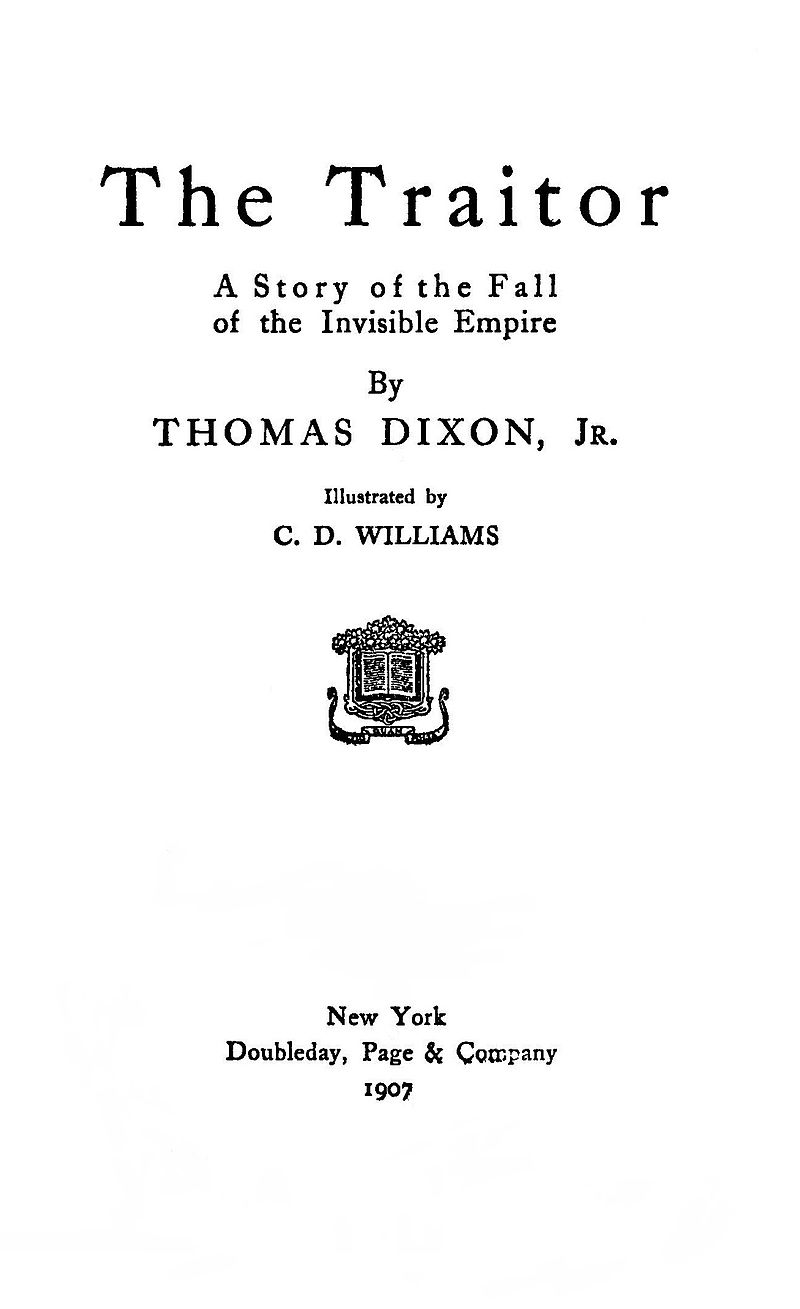
Above the title page of the novels First Edition.
The story is a thinly disguised look at the actual events that dissolved the original Klan and the rising of the current Klan. In the novel "John Graham", a Confederate Civil War veteran, and "Grand Dragon of the North Carolina Klan". Is ordered by the "Grand Wizard of the Klan" to have one last march through town and afterwards discontinue their activities. After the march his members are to burn their robes and bury them in an unmarked grave. As the Klan's good work is finished.
"The Traitor" is a rival for "Graham's" leadership and two weeks after the above takes place. He reorganizes the Klu Klux Klan as an evil organization that still existed at the time of Dixon's novel's publication.
The actual "First Grand Wizard of the Klu Klux Klan", who did order the above disbanding, was ex-Confederate Army General Nathan Bedford Forest seen below.
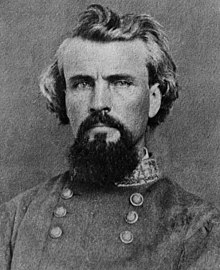
The actual reviving of the Klu Klux Klan took place in 1915 in Atlanta, Georgia, by White Protestants and not only was anti-black, but anti-Jewish, anti-Catholic and anti-Foreigners and remains as such as of this writing. This reawakening may have also added to the controversy over D.W. Griffith's motion picture of the same year.
The Lead Up to D.W. Griffith's "The Birth of a Nation".
After 1910's "In Old California", D.W. Griffith directed 9 feature length films, approximately one hour each, with 3 of them made in 1914. This was because the silent film industry, during the infancy of American motion pictures, was mainly turning out short fills for vaudeville theaters to use between main acts. Although venues for motion picture shorts were appearing as early as 1902.
Those short films might run for as little as ten minutes, but some made it to 30 minutes and were billed as "Feature Length". D.W. Griffith directed 258 shorts between 1910 and 1914, but what was to come next would change the face of the motion picture industry forever.
But first, in either 1915, itself, or 1916, depending on the source. Actor Noble Johnson and his brother George founded the first all "Black" owned and operated film studio "The Lincoln Motion Picture Company". Their company made feature films directed at the "Colored" population and the studio's goal was to oppose the racial stereo types found in "The Birth of the Nation" and other pictures. Strangely, while "The Birth of a Nation" was considered a "Normal" film production by reviewers at the time. Motion pictures made by "The Lincoln Motion Picture Company" and the other "Black" owned studios would be termed "Race Movies".

Noble Johnson is the tall man in the center of the above still at his studio.
The motion pictures made by Noble and George Johnson could not be shown in the same movie houses that "The Birth of the Nation" was seen. As segregation was not just throughout the Southern United States, but existed in major cities across the country including Downtown Los Angeles and, as I gave my reader a link too, "Hollywood" with the "White" controlled movie studios.
"The Lincoln Motion Picture Company's" product had to be seen in segregated movie theaters for "Black's Only". Yet, "Black" actors, like Noble Johnson, could be seen in "Hollywood" motion pictures shown in both "White" and "Black" movie houses.
For those of my readers who do not recognize Noble Johnson. I give you the following most recognizable still of the actor from 1933's classic "King Kong".

The characters of the novel.
ntroduce a bill to impeach "President Andrew Johnson".
"Lydia Brown" housekeeper.
"Jeannie Lenoir"
"Gus"Ben Cameron"
complicity in the assassination of Abraham Lincoln.
"Mrs. Gloria Cameron"
"Benjamin 'Ben' Cameron"
is portrayed, by Dixon, Jr., as a sympathetic character to the South. Who sought to restore normalcy by shipping former slaves back to Africa
"President Andrew Johnson", "Lincoln's" successor, is shown as being impeached, but not convicted by Congress. According to Dixon, Jr. this is for opposing the Northern Reconstruction of the South and no other issue.
There are two of other minor characters just described by Thomas Dixon, Jr. as "Mammy" and "Jake".
The basic plot of the novel can be found in the above character descriptions. However, the character of "Congressman Austin Stoneman" was a very thinly disguised reference to real Massachusetts Representative Thaddeus Stevens. Who was a radical Republican Party Member that wanted the Reconstruction of the Southern States to be a means of acquiring the Negro votes to keep the party in power. Dixon uses this characterization to fight the idea of giving those "Black" emancipated slaves the same voting rights as a "White" Southerner.

Above Thaddeus Stevens.
While "The Leopard's Spots" seemed to go unnoticed by the American public. "The Clansman" not only caused reprisals in the Northern United States, but, surprisingly, also in the Southern United States. Thomas Dixon, Jr. was denounced for renewing and glorifying an "unfortunate" period of time most 1905 Southerners didn't want remembered.
When offered a membership in the "KKK", Dixon, reportedly turned it down. Thomas Dixon claimed he did not agree with the Klan's methods. Even though both of his novels made their members the "Good Guys" and the emancipated slaves the "Bad Guys".
The final novel of Dixon's Trilogy is "The Traitor: A Story of the Fall of the Invisible Empire", published in 1907.

Above the title page of the novels First Edition.
The story is a thinly disguised look at the actual events that dissolved the original Klan and the rising of the current Klan. In the novel "John Graham", a Confederate Civil War veteran, and "Grand Dragon of the North Carolina Klan". Is ordered by the "Grand Wizard of the Klan" to have one last march through town and afterwards discontinue their activities. After the march his members are to burn their robes and bury them in an unmarked grave. As the Klan's good work is finished.
"The Traitor" is a rival for "Graham's" leadership and two weeks after the above takes place. He reorganizes the Klu Klux Klan as an evil organization that still existed at the time of Dixon's novel's publication.
The actual "First Grand Wizard of the Klu Klux Klan", who did order the above disbanding, was ex-Confederate Army General Nathan Bedford Forest seen below.

The actual reviving of the Klu Klux Klan took place in 1915 in Atlanta, Georgia, by White Protestants and not only was anti-black, but anti-Jewish, anti-Catholic and anti-Foreigners and remains as such as of this writing. This reawakening may have also added to the controversy over D.W. Griffith's motion picture of the same year.
The Lead Up to D.W. Griffith's "The Birth of a Nation".
After 1910's "In Old California", D.W. Griffith directed 9 feature length films, approximately one hour each, with 3 of them made in 1914. This was because the silent film industry, during the infancy of American motion pictures, was mainly turning out short fills for vaudeville theaters to use between main acts. Although venues for motion picture shorts were appearing as early as 1902.
Those short films might run for as little as ten minutes, but some made it to 30 minutes and were billed as "Feature Length". D.W. Griffith directed 258 shorts between 1910 and 1914, but what was to come next would change the face of the motion picture industry forever.
But first, in either 1915, itself, or 1916, depending on the source. Actor Noble Johnson and his brother George founded the first all "Black" owned and operated film studio "The Lincoln Motion Picture Company". Their company made feature films directed at the "Colored" population and the studio's goal was to oppose the racial stereo types found in "The Birth of the Nation" and other pictures. Strangely, while "The Birth of a Nation" was considered a "Normal" film production by reviewers at the time. Motion pictures made by "The Lincoln Motion Picture Company" and the other "Black" owned studios would be termed "Race Movies".

Noble Johnson is the tall man in the center of the above still at his studio.
The motion pictures made by Noble and George Johnson could not be shown in the same movie houses that "The Birth of the Nation" was seen. As segregation was not just throughout the Southern United States, but existed in major cities across the country including Downtown Los Angeles and, as I gave my reader a link too, "Hollywood" with the "White" controlled movie studios.
"The Lincoln Motion Picture Company's" product had to be seen in segregated movie theaters for "Black's Only". Yet, "Black" actors, like Noble Johnson, could be seen in "Hollywood" motion pictures shown in both "White" and "Black" movie houses.
For those of my readers who do not recognize Noble Johnson. I give you the following most recognizable still of the actor from 1933's classic "King Kong".
My article "NOBLE JOHNSON AFRICAN-AMERICAN PIONEERING ACTOR" can be read at:
http://www.bewaretheblog.com/2015/06/noble-johnson-african-american-pioneer.html
The Lost 1911 Version of "The Clansman"
Producer George Brennan had purchased the rights to Thomas Dixon, Jr's novel. He chose director William F. Haddock for his filmed project. Between 1909 and 1919 Haddock would make 82 shorts and 6 feature films.
The unfinished 1911 "The Clansman" was partially shot at "Homewood Plantation", in Natchez, Mississippi. The plantation house survived the American Civil War and was completely untouched by it. The same building would also be used for some scenes in D.W. Griffith's 1915 motion picture.
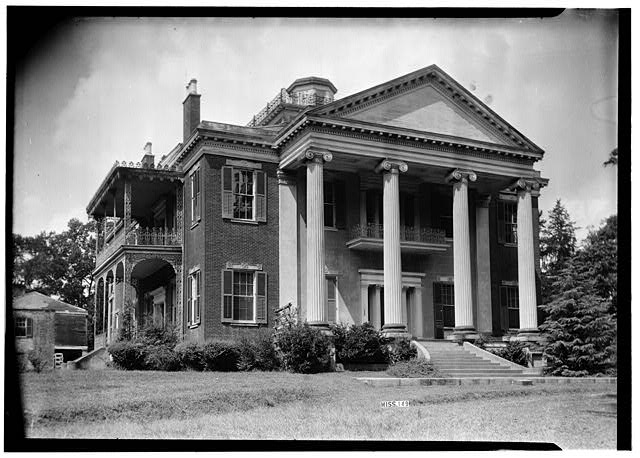
The problem for producer George Brennan was his decision to film "The Clansman" in "Kinemacolor". Which was the first successful color motion picture process. "Kinemacolor" would be used for 54 dramatic films and four shorts between 1909 and 1918.
There was a special showing of the one and a half reels of color footage Haddock had shot. The showing had been planned to attract financial backers, but Brennan could not get any. However, attending that viewing was movie critic Frank E. Woods.

Frank Woods was also a silent film screenplay writer and would write 90 films between 1908 and 1925. It was Woods that brought to David Wark Griffith's attention Brennan's 1911's "The Clansman". Frank Woods became the co-screenplay writer on 1915's "The Birth of a Nation.
The production was co-produced by Griffith and Harry "H.E. Aitken. Aitken only produced four motion pictures and this was his third. Of the other three he did produced. They included the May 9, 1914, entirely fictional, release "The Life of General Villa". Which had the real Mexican revolutionary, Francisco "Pancho" Villa, playing himself.

Villa is on a horse, in front, looking to his left in the above still from the motion picture.
D.W. Griffih's: THE CLANSMAN aka: THE BIRTH OF A NATION released February 8, 1915

Look at the poster on the right of this movie theater showing D,W, Griffith's motion picture. Notice that it reads:
100,000,000 PEOPLE HAVE SEEN IT. HAVE YOU?According to James Monaco in his 2009 "How to Read a Film: Media, and Beyond" published by the "Oxford University Press":
The Birth of a Nation, costing an unprecedented and, many believed, thoroughly foolhardy $110,000, eventually returned $20 million and more. The actual figure is hard to calculate because the film was distributed on a "states' rights" basis in which licenses to show the film were sold outright. The actual cash generated by The Birth of a Nation may have been as much as $50 million to $100 million, an almost inconceivable amount for such an early film.
The running time of the feature was originally 3 hours and 13 minutes. However, depending on which State the film was shown. Local "State Censors" cut the film by an average of one hour, before permitting its screening.
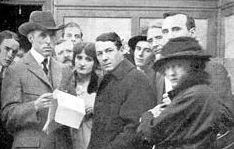
.
Above, on the left, and holding part of the script for "The Clansman" is D.W. Griffith on the motion picture's set. Below Griffith with Cameraman Billy Bitzer filming a scene.

Of course there are changes from Dixon, Jr's novel in the Griffith and Wood's screenplay. The following are the 8 main characters of the motion picture. In all there are 24 on screen credited roles and 35 minor non on screen credited roles. Not to mention the extra's.
Henry B. Walthall was "Colonel Ben Cameron" aka: "The Little Colonel". Walthall over his career would be a favorite of D.W. Griffith and Todd Browning. Among his other films were Browning's 1926 "The Road to Mandalay" and 1927's "London After Midnight". Both starred Lon Chaney, he was in Todd Browning's 1936 "The Devil Doll" and for Griffith would been seen in 1914's "The Avenging Conscience:, or 'Thou Shalt Not Kill'" and the 1930 "Abraham Lincoln" among several other motion pictures.

Lillian Gish portrayed "Elsie Stoneman". Gish's screen career started in 1912 and would cover 75 years. Among her films are Griffith's 1916 "Intolerance', King Vidor's 1946 "Duel in the Sun" starring Gregory Peck and Jennifer Jones, Charles Laughton's 1955 "Night of the Hunter" starring Robert Mitchum and Shelley Winters, John Huston's 1960 "The Unforgiven" starring Burt Lancaster and Audrey Hepburn and Lindsey Anderson's 1987 "The Whales of August" co-starring with Bette Davis and Vincent Price. Below a restored rare color still of Lilian Gish filming "The Birth of a Nation".

Mae Marsh was "Flora Cameron" known as "The Pet Sister", because of her age . Marsh also appeared in D.W. Griffith's 1916 "Intolerance", but became a character actress without on screen credit for most of her career. Among her work for John Ford alone included 1939's "Drums Along the Mohawk", 1940's "The Grapes of Wrath", 1941's 'Tobacco Road", 1941's "How Green Was My Valley", 1946's "My Darling Clementine", 1948's "Fort Apache", 1948's "3 Godfathers", 1952's "The Quiet Man", 1956's "The Searchers", 1957's "Wings of Eagles", 1960's "Sergeant Rutledge" and 1964's "Cheyenne Autumn".
Below left to right, Mae Marsh, Lilian Gish and Henry Walthall

Miriam Cooper portrayed "Margaret Cameron" "The Elder Sister". Cooper started acting in 1910 and stopped in 1924. Most of her motion pictures were Civil War dramas and she did her own stunts.
Above Miriam Cooper in "The Birth of the Nation". Below Cooper doing her own stunt work in 1913's "The Railroad Inspectors Peril" without any safety harnesses.

Mary Allen portrayed "Lydia Brown" the "Stoneman's" mulatto housekeeper. Among her films were Griffith's 1916 "Intolerance", a 1916 production of William Shakespeare's "Macbeth" and in 1926 she co-starred in "Brown of Harvard". A film probably more remembered for a USC Football player playing the non on screen credited, type cast, role of a football player. The actor was Marion Robert Morrison. Who in 1930, was given, by director Raul Walsh, the new name of John Wayne.

Above "White" actress Mary Allen and below with Lilian Gish in "The Birth of a Nation".

Ralph Lewis was "The Honorable Austin Stoneman the Leader of the House". Character actor Lewis started acting in 1912 and ended 172 roles later in Cecil B. DeMille's "The Buccaneer". Below Lilian Gish with Ralph Lewis as "Stoneman".

George Siegmann portrayed "Silas Lynch the Mulatto Lieutenant Governor". Among his films were D.W. Griffith's 1914 "The Avenging Conscious" and 1916's "Intolerance". He was "King Armud of Sheba" in 1921's "The Queen of Sheba", "Porthos" in a 1921 version of "The Three Musketeers" and "Bill Sikes" in a 1922 version of "Oliver Twist".

Above Siegmann without make-up and below as "Silas Lynch" on the left, with Ralph Lewis, Lilian Gish and Henry Walthall.
.jpg)
From a strictly film history point of view. "The Birth of a Nation" was the first "Epic" motion picture. Made at a time when, as I have mentioned previously, feature films averaged one hour in length. "The Birth of a Nation" was divided into two parts: "Civil War of United States" and "Reconstruction". Between these two parts Griffith created the first "Intermission".

The above posted might publicity wise exaggerate the cast and cost, but the fact that there were only two showings a day goes to the length of the original "Road Show" engagement plus that first "Intermission". A $5 dollar 1915 seat would equate in 2019 to $126 dollars.
The following is the story as presented by producer and director D.W. Griffith.
Part One: Civil War of United States
The Set Up"
The screenplay follows the events in the lives of two families whose politics are opposites.
One is the "Northern Stoneman's". It is headed by "Abolitionist U.S. Representative Austin Stoneman". He has two daughters and three sons.There is no wife mentioned in the complete cast list. Other than Lilian Gish as "Elsie Stoneman", There is also no listing for who portrayed the second daughter, or the daughter's name. Although there is a listing for a Mary Wynn in a "Minor role" that might be the sister.
There are two other actors with on screen credit. Robert Harron portrayed "Tod the youngest Stoneman son" and Elmer Clifton was "Phil, the Stoneman's Elder Son". Who played, the third "Stoneman" son, or the character's name is not listed. Although there are two actors with no on screen credit in what are called "Minor Roles".
The other family are the "Southern Cameron's" led by "Doctor", portrayed by Spottiswood Aitken, and "Mrs" Cameron", played by Josephine Crowell. They have three sons and two daughters. Besides Henry Walthall as "Ben Cameron". The other two "Cameron" sons are "Wade" the second son, portrayed by George Beranger, and "Duke", the youngest son, portrayed by Maxfield Stanley. Stanley used the screen name of John French. The two daughters, as already noted above, are portrayed by Mae Marsh and Miriam Cooper.
The screenplay first mentions that these events are happening "many years" after the South has brought African slaves to the United States and the Northern Abolitionists "are demanding" that the Southern Plantation owners free them.
The Visit:
The "Stoneman" sons "Phil" and "Tod" visit the "Cameron's", Piedmont, South Carolina Plantation. Their visit is because "Phil" wants to see his old school mate "Ben Cameron". At the plantation "Phil" meets and falls in love with "Margaret Cameron". "Tod Stoneman" and "Duke Cameron" become very close friends. While "Ben" sees the locket carried by "Phil" with a picture of his sister "Elsie" and starts to idolize the young women he never met.
The visit is cut short when President Abraham Lincoln, portrayed by Joseph Henabery, calls for volunteers as the South has succeeded from the Union.
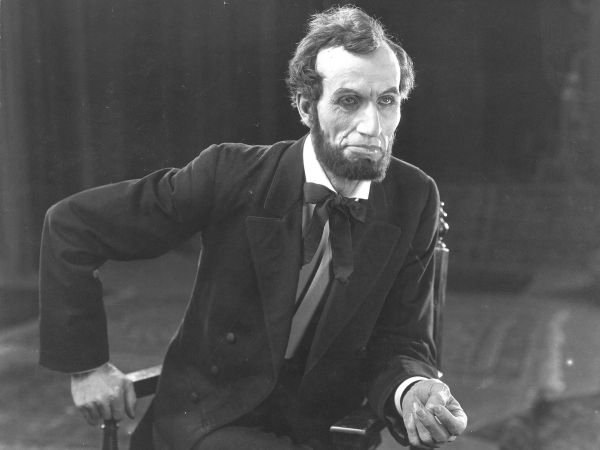
"Phil" and "Tod" leave for home, but not before "Ben" steals the locket containing the portrait of the women he is starting to love.
The War:
The "Stoneman" and "Cameron" sons are full of righteousness for their respective causes and join their "Countries" armies. As the troops begin to march.....

As America's Civil War progresses, in a battlefield engagement Confederate soldier "Duke Cameron" and Union Soldier "Tod Stoneman" will die in each others arms.
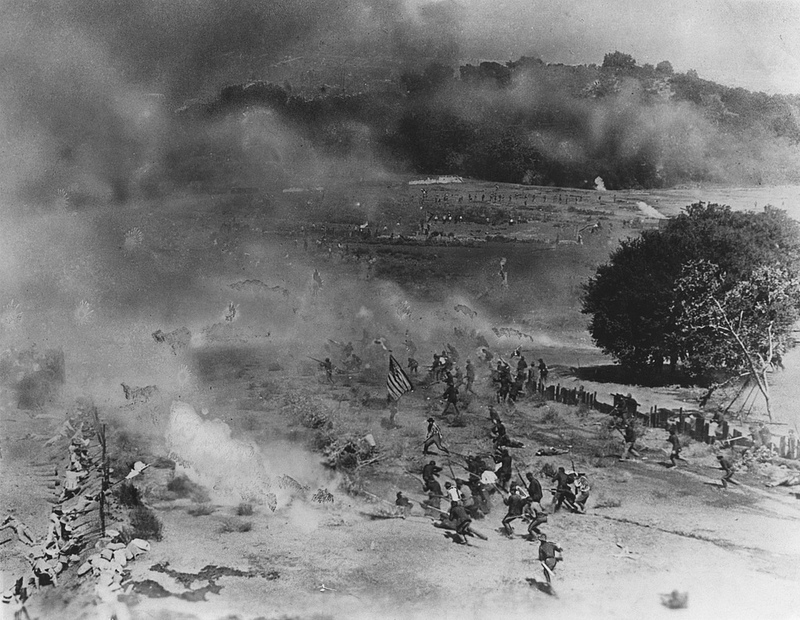
The burning of Atlanta, by Northern General Sherman, takes place and Sherman "Marches to the Sea". The picture switches to General Ulysses S. Grant, portrayed by Donald Crisp, 1941's "How Green in My Valley" and "Dr Jekyll and Mr. Hyde", 1943's "Lassie Come Home" and 1944's "National Velvet", at the "Siege of Petersburg", Virginia. "Colonel Ben Cameron" leads a heroic, but fruitless counter attack on Grant and earns the nickname "The Little Colonel".

Above Elmer Clifton as "Phil Stoneman" finds his wounded childhood friend "Ben Cameron", Henry B. Walthall at the "Battle of Petersburg". "Ben" wakes up in a Washington, D.C. hospital.

"Mrs. Cameron" goes to President Lincoln and pleads for her son's pardon "from an unfounded charge". Which is granted by Southern sympathetic Lincoln.


Mary Allen portrayed "Lydia Brown" the "Stoneman's" mulatto housekeeper. Among her films were Griffith's 1916 "Intolerance", a 1916 production of William Shakespeare's "Macbeth" and in 1926 she co-starred in "Brown of Harvard". A film probably more remembered for a USC Football player playing the non on screen credited, type cast, role of a football player. The actor was Marion Robert Morrison. Who in 1930, was given, by director Raul Walsh, the new name of John Wayne.

Above "White" actress Mary Allen and below with Lilian Gish in "The Birth of a Nation".

Ralph Lewis was "The Honorable Austin Stoneman the Leader of the House". Character actor Lewis started acting in 1912 and ended 172 roles later in Cecil B. DeMille's "The Buccaneer". Below Lilian Gish with Ralph Lewis as "Stoneman".

George Siegmann portrayed "Silas Lynch the Mulatto Lieutenant Governor". Among his films were D.W. Griffith's 1914 "The Avenging Conscious" and 1916's "Intolerance". He was "King Armud of Sheba" in 1921's "The Queen of Sheba", "Porthos" in a 1921 version of "The Three Musketeers" and "Bill Sikes" in a 1922 version of "Oliver Twist".

Above Siegmann without make-up and below as "Silas Lynch" on the left, with Ralph Lewis, Lilian Gish and Henry Walthall.
.jpg)
From a strictly film history point of view. "The Birth of a Nation" was the first "Epic" motion picture. Made at a time when, as I have mentioned previously, feature films averaged one hour in length. "The Birth of a Nation" was divided into two parts: "Civil War of United States" and "Reconstruction". Between these two parts Griffith created the first "Intermission".

The above posted might publicity wise exaggerate the cast and cost, but the fact that there were only two showings a day goes to the length of the original "Road Show" engagement plus that first "Intermission". A $5 dollar 1915 seat would equate in 2019 to $126 dollars.
The following is the story as presented by producer and director D.W. Griffith.
Part One: Civil War of United States
The Set Up"
The screenplay follows the events in the lives of two families whose politics are opposites.
One is the "Northern Stoneman's". It is headed by "Abolitionist U.S. Representative Austin Stoneman". He has two daughters and three sons.There is no wife mentioned in the complete cast list. Other than Lilian Gish as "Elsie Stoneman", There is also no listing for who portrayed the second daughter, or the daughter's name. Although there is a listing for a Mary Wynn in a "Minor role" that might be the sister.
There are two other actors with on screen credit. Robert Harron portrayed "Tod the youngest Stoneman son" and Elmer Clifton was "Phil, the Stoneman's Elder Son". Who played, the third "Stoneman" son, or the character's name is not listed. Although there are two actors with no on screen credit in what are called "Minor Roles".
The other family are the "Southern Cameron's" led by "Doctor", portrayed by Spottiswood Aitken, and "Mrs" Cameron", played by Josephine Crowell. They have three sons and two daughters. Besides Henry Walthall as "Ben Cameron". The other two "Cameron" sons are "Wade" the second son, portrayed by George Beranger, and "Duke", the youngest son, portrayed by Maxfield Stanley. Stanley used the screen name of John French. The two daughters, as already noted above, are portrayed by Mae Marsh and Miriam Cooper.
The screenplay first mentions that these events are happening "many years" after the South has brought African slaves to the United States and the Northern Abolitionists "are demanding" that the Southern Plantation owners free them.
The Visit:
The "Stoneman" sons "Phil" and "Tod" visit the "Cameron's", Piedmont, South Carolina Plantation. Their visit is because "Phil" wants to see his old school mate "Ben Cameron". At the plantation "Phil" meets and falls in love with "Margaret Cameron". "Tod Stoneman" and "Duke Cameron" become very close friends. While "Ben" sees the locket carried by "Phil" with a picture of his sister "Elsie" and starts to idolize the young women he never met.
The visit is cut short when President Abraham Lincoln, portrayed by Joseph Henabery, calls for volunteers as the South has succeeded from the Union.

"Phil" and "Tod" leave for home, but not before "Ben" steals the locket containing the portrait of the women he is starting to love.
The War:
The "Stoneman" and "Cameron" sons are full of righteousness for their respective causes and join their "Countries" armies. As the troops begin to march.....

As America's Civil War progresses, in a battlefield engagement Confederate soldier "Duke Cameron" and Union Soldier "Tod Stoneman" will die in each others arms.

The burning of Atlanta, by Northern General Sherman, takes place and Sherman "Marches to the Sea". The picture switches to General Ulysses S. Grant, portrayed by Donald Crisp, 1941's "How Green in My Valley" and "Dr Jekyll and Mr. Hyde", 1943's "Lassie Come Home" and 1944's "National Velvet", at the "Siege of Petersburg", Virginia. "Colonel Ben Cameron" leads a heroic, but fruitless counter attack on Grant and earns the nickname "The Little Colonel".

Above Elmer Clifton as "Phil Stoneman" finds his wounded childhood friend "Ben Cameron", Henry B. Walthall at the "Battle of Petersburg". "Ben" wakes up in a Washington, D.C. hospital.

"Mrs. Cameron" goes to President Lincoln and pleads for her son's pardon "from an unfounded charge". Which is granted by Southern sympathetic Lincoln.

At this point D.W. Griffith has the meeting, at the Appomattox Court Yard, between Union General Grant and Confederate General Robert E. Lee, portrayed by Howard Gaye.
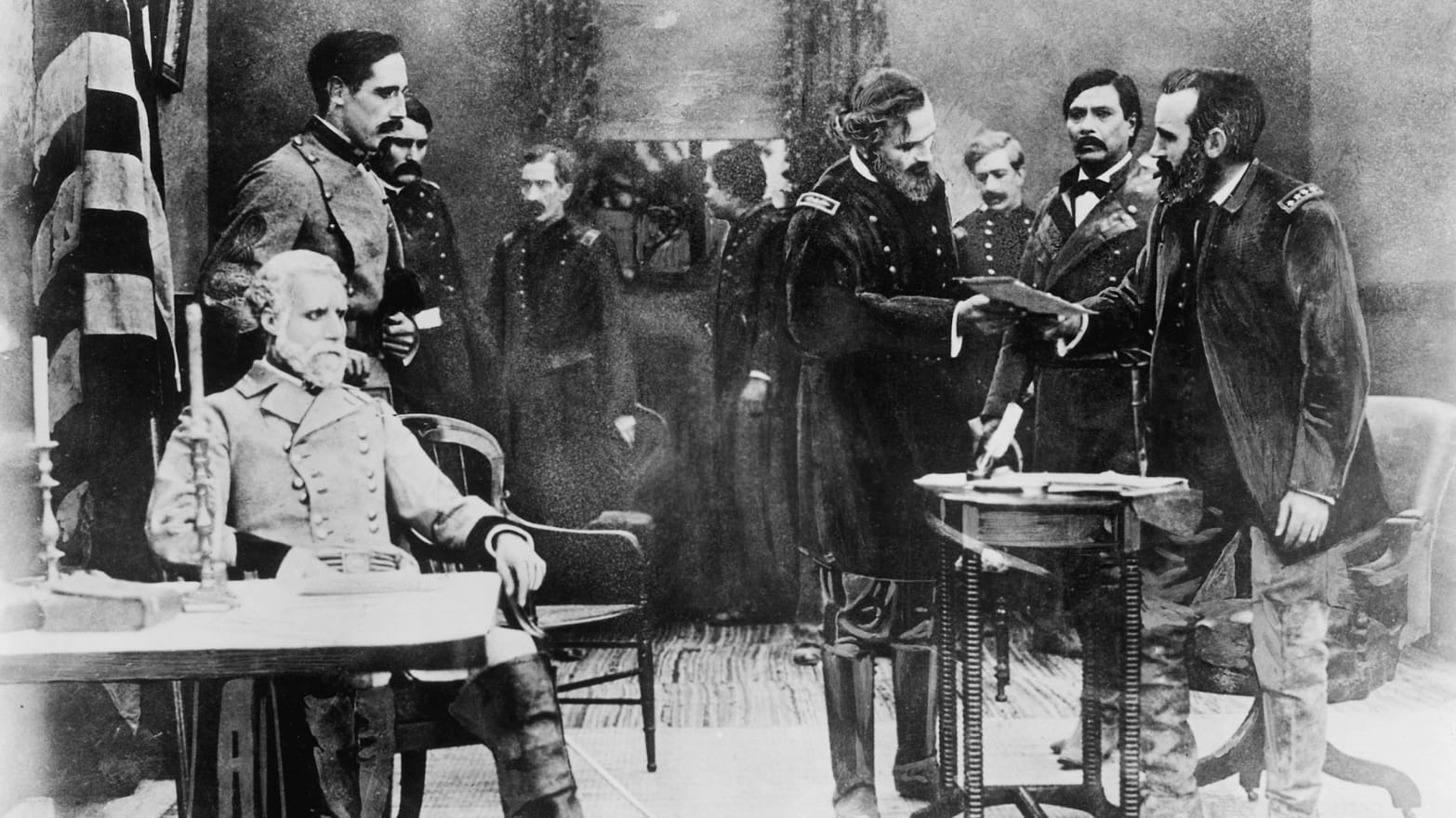
President Lincoln and he wife portrayed by actress Alberta Lee, attend "Ford's Theater". Suddenly John Wilkes Booth, portrayed by director Raoul Walsh, 1924's "The Thief of Bagdad", 1939 "The Roaring Twenties", 1941's "They Died with Their Boots On", 1949's "White Heat" and 1955's "Battle Cry", appears and assassinates the President.

With Lincoln dead "Austin Stoneman" becomes very powerful in the "House of Representatives" and with other radical Republicans creates laws to punish the Southern States. Which according to D.W. Griffith were typical of the "Reconstruction Era".
INTERMISSION
Part Two: Reconstruction
Congressional Representative "Stoneman" now sends his protege, "Silas Lynch", to South Carolina to oversee that State's "Reconstruction". "Lynch" is introduced by Griffith as a psychopathic half "White Man" and with the backing of "Stoneman" and the "Radical Republicans". "Lynch" begins voter registration of all the ex-slaves in South Carolina.
D,W. Griffith has both African-American extra's mixed with "White" actors in "Blackface". As a result of the election the South Carolina State Legislature is depicted, by Griffith, as almost solid "Black" and its members shown mostly drunk, or acting juvenile.


Additionally, "Silas Lynch" is elected, by the "Black" majority, Lieutenant Governor. "Representative Stoneman" now goes to Piedmont to check on the progress of his protege. He takes "Elsie" and "Phil" with him. but "Phil" finds "Margret Cameron" very cold towards him as a result of the war. While "Elsie" falls in love with and becomes engaged to "Ben Cameron",
However, the disenfranchised "White's" believe that the "Carpetbaggers" led by "Silas Lynch" must be driven out of South Carolina and the State restored to the proper "Racial Balance". "Ben Cameron" now creates the "Klu Klux Klan".
At this point in the picture D.W. Griffith has a title card created quoting Virginia born President Woodrow Wilson, Who also screened "The Birth of a Nation" in the White House. Making it the first motion picture shown there.
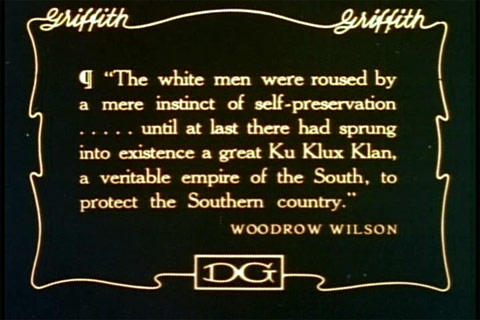
An article about President Wilson's statue being removed from the grounds of the "University of Texas" in 2015, because of his racist policies can be found at:
https://www.kut.org/post/woodrow-wilson-statue-removal-prompts-closer-look-his-history-race-relations
Learning that "Ben" is a "Clansman" "Elsie" breaks off their engagement. One of "Silas Lynch's" followers, an ex-soldier and "Renegade Negro" named "Gus", portrayed by Walter Long, finds "Flora Cameron" alone in a wooded area.

"Gus" asks "Flora" to marry him, but she believes he really wants to rape her. In panic "Flora" starts to run away and goes over a cliff. "Ben" finds his younger sister and she dies in his arms.
The "Klan" captures "Gus" and "Honorably Hangs" him for the murder of "Flora".

Next "Dr. Cameron" is arrested for having "Klan Costumes" in his house, but is rescued by "Phil Stoneman" and the "Cameron's" black servants, but along with "Margaret" and "Mrs. Cameron" become trapped in a cabin.

Meanwhile, "Black" militia troops invade the streets of Piedmont. While "Silas Lynch" asks "Elsie Stoneman" to be the "Queen of His Black Empire".

"Elsie" has just held off "Silas" when her father arrives. He hears what "Lynch" wants to do with "Elsie", but her father tells his daughter he is powerless to prevent a forced marriage.
"Ben" and the "Klan" arrive in Piedmont to drive off and kill the "Black" militia.
.jpg)
Next "Ben" and his men rescue "Elsie" and her father from "Silas Lynch" and proceed to rescue the others in the cabin.


Above on the right is Henry B. Walthall as "Ben Cameron", but it is the rider to his left that is of interest. That actor is John Ford two years before he directed his first film. A 30 minute 1917 Western short entitled "The Tornado". For that short Ford listed himself as the director Jack Ford and as actor John Ford.
"The Birth of a Nation" ends with the double honeymoon of "Ben and Elsie" and "Phil" and "Margaret". Cutting too an Epilogue of the millennium with the "Resurrection of Jesus Christ" binding peoples and nations together.
The Three Responses to D.W. Griffith's 1915 "The Birth of a Nation".
1. 1915 Protests.

Above protesters in New York City are in front of a theater showing D.W. Griffith's motion picture.
Writer David Copeland in his 2010 article 'The Media's Role in Defining the Nation". Found in publisher Peter Lang's "The Active Voice", no issue given, wrote:
by the time of the movie's March 3 [1915] premiere in New York City, its subject matter had embroiled the film in charges of racism, protests, and calls for censorship, which began after the Los Angeles branch of the NAACP requested the city's film board ban the movie. Since film boards were composed almost entirely of whites, few review boards initially banned Griffith's pictureThen there was Newspaper editor William Monroe Trotter founder of the "Boston Guardian" back in 1901.

Trotter organized protests on April 10th and 17th and with a group of "Black Activists" attempted to purchase tickets at the "Tremont Theatre" to see "The Birth of a Nation".

After being refused ticket purchases on April 10, 1915. A larger group returned to purchase tickets on April 17th and once more was refused. Trotter and the others started to protest and 260 Boston Police, on stand-by at the Tremont, moved in and a minor riot broke out, Trotter and 10 others were arrested.
The "NAACP" established a National Boycott of the motion picture and D.W. Griffith's film was actually banned in three States and many other cities.
American Social Worker and the founder of "Hull House", Jane Addams, was quoted in a March 13,1915 interview in the "New York Post":
One of the most unfortunate things about this film is that it appeals to race prejudice upon the basis of conditions of half a century ago, which have nothing to do with the facts we have to consider to-day. Even then it does not tell the whole truth. It is claimed that the play is historical: but history is easy to misuseBoth D.W. Griffith and Thomas Dixon, Jr. both defended the film against the many attacks and each would respond in a cinematic way in 1916.
2. The Sequel
I mentioned earlier that Thomas Dixon, Jr. was a film maker. In 1916 Dixon first published, with D. Appleton and Company, another novel entitled "The Fall of a Nation: A Sequel to a Birth of a Nation".

This was an example of the "Invasion Genre" of writing found in the United Kingdom between 1871 and the start of the First World War. This genre was used in politics to build upon the concept of the "White People" against "The Other Races", or "Invaders".
Also in 1916 Thomas Dixon, Jr., turned his novel into a new feature film also entitled "The Fall of a Nation: A Sequel to the Birth of a Nation". Which he produced, wrote and directed, Below one piece of the advertising for the motion picture.

Whereas D.W. Griffth's 1915 "The Birth of a Nation" is considered the first "Epic Motion Picture" and the inventor of the "Road Show Intermission". Thomas Dixon, Jr's 1916 "The Fall of a Nation: A Sequel to a Birth of the Nation" is considered the first "Sequel" to a motion picture.
The motion picture opens with a recreation of the sinking of the "Lusitana". Followed by American millionaire "Charles Waldron", portrayed by Percy Standing, joining in a conspiracy to overthrow the American Government. A large German force, known as the "European Confederate Army", invades the United States and starts to execute citizens.

The American pacifists are taken by surprise as they have believed the United States had no enemies. The America is conquered and "Waldron" is made a "Prince".
The next section of the film shows America under German Rule and is followed by the rise of a suffragette named "Virginia Holland", portrayed by Lorraine Huling. She forms a rebel army, known as "The Daughters of Jael", that overthrow the Germans and restore the United States government.
Note: "Jael" was a biblical heroine in the "Book of Judges", She killed "Sisera", Commander of the Canaanite army, and delivers Israel from the Canaanite King "Jabin".
"Virginia" next makes plans to marry "Congressman John Vassar", portrayed by Arthur Shirley, who assisted her with the army and had lobbied for increased military preparedness prior to the invasion.
The motion picture is considered a "Lost Film".
3. D.W. Griffith Fights Back
On September 5, 1916 D.W. Griffith released "Intolerance: Loves Struggle Throughout the Ages" aka: "Intolerance: A Sun Play of the Ages".

Besides D.W. Griffith the screenplay had five other writers. These were:
Tod Browning, who received no on screen credit. This was the future director of several Lon Chaney motion pictures and the 1931 Bela Lugosi "Dracula's" 5th screenplay.
Hettie Grey (or Gray) Baker was a film editor turned screenplay writer. This was her 19th of 24 screenplays.
Anita Loos is probably remembered best for her novel "Gentleman Prefer Blondes". Loos wrote 139 screenplays between 1912 and 1961. For this production she wrote the title cards.
Mary H. O'Connor wrote 29 screenplays and "Intolerance" was her 21st.
Frank E. Woods wrote 94 screenplays between 1908 and 1925. This was his 81st screenplay.
Each contributed to what is considered D.W. Griffith's response to the criticism he received over the racial stereo typing of "The Birth of a Nation", but Griffith emphasized "Intolerance" was not an "Apology" for that previous motion picture. However, in all the interviews about the picture D.W. Griffith gave. He went out of his way to make it clear that both the feature's title and themes were aimed at those he felt had been "Intolerant" with him over making the 1915 Civil War drama.
The original release ran 3 hours and 30 minutes plus an "Intermission" and was broken into four parallel stories that the screenplay intercuts between. As the motion picture reaches its climax these intercuts become faster and more often.
1. A contemporary melodrama about Crime and Redemption.

2. A Judean Story: Christ's mission and death.

3. A French story: The events surrounding the "St. Bartholomew's Day Massacre of 1572.
_01.jpg)
4. A Babylonian Story: The Fall of the Babylonian Empire to Persia 539 B.C.
The purpose of the screenplay was to "Demonstrate Humankind's Persistent Intolerance" throughout the ages, or again toward D.W. Griffith, in his mind, over his point of view on the American Civil War and Reconstruction.
Lillian Gish portrayed the "Eternal Motherhood" tying all four stories together. A total of 36 actors had on screen credited roles in the picture and another 25 had non on screen credited roles.
On March 21, 2016, Film Historian and Scholar Frank Beaver wrote "A Century After Intolerance" for the "Regents of the University of Michigan"stating the following:
Nine years after the release of "The Birth of a Nation", actress, Mary Pickford, was quoted, in the January 1924 issue of the magazine "Photoplay", saying of the film, by her co-founder of "United Artists Pictures":
Fourteen years after "Intolerance" David Wark Griffith returned to the American Civil War and made:
ABRAHAM LINCOLN released August 25, 1930
_03.jpg)
The motion picture was co-produced and directed by Griffith. His co-producer was Joseph M. Schenck. Between 1917 and 1936 Russian born Schenck directly produced 77 feature films and between 1917 to 1936 was a "Producer and Presenter" of 133 other motion pictures including "Abraham Lincoln" for different studios including the Griffith, Pickford and Fairbanks Studio "United Artists".
The screen play was by American Poet and Short Story writer Stephen Vincent Benet. Benet is known for his long 1928 poem "John Brown's Body". For which he won the Pulitzer Prize. Benet is also known for the 1936 short story "The Devil and Daniel Webster".
John W. Considine, Jr. co-wrote the screenplay, but would be known as a producer for motion pictures such as Peter Lorre's 1935 "Mad Love", 1940's "Young Tom Edison" starring Mickey Rooney and its sequel "Edison the Man" starring Spencer Tracy.
Gerrit J. Lloyd wrote additional dialogue for this picture and 4 other D.W. Griffith films.
The role of "Abraham Lincoln" was portrayed by Walter Huston. This was Huston's 9th feature film including the 1929 Gary Cooper Western "The Virginian". In 1941 he had a small role in his son, John's, "The Maltese Falcon" and co-starred in John's 1948 "The Treasure of the Sierra Madre". Walter Huston's other work included 1932's "Rain" opposite Joan Crawford and 1942's "Yankee Doodle Dandy" as James Cagney's father.

Una Merkel portrayed Ann Ruthledge. Merkel once a stand in for Lillian Gish, became a classic motion picture comedian after this motion picture. Below she is with Huston in the first part of the feature.

Kay Hammond was Mary Todd Lincoln. Hammond only has 11 film roles to her credit and this is her one major performance. Below she is in "Ford's Theater" with Huston's Lincoln.

The shorter first part dealt with Lincoln becoming a lawyer and his early romance with Ann Ruthledge. The majority over the motion picture deals with the Civil War, his marriage to Mary Todd, and climaxes with Lincoln's assassination.
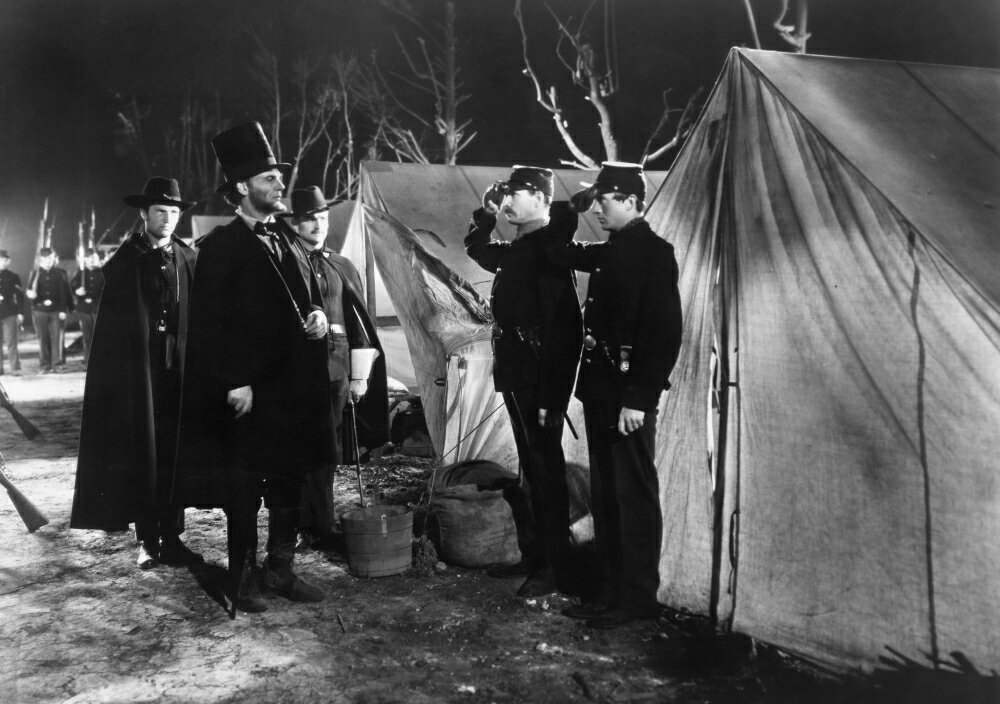

At the time of its release, "Variety", went straight to the fear that "Abraham Lincoln" would showcase Griffith's Southern Racial views and be a new "The Birth of a Nation", writing:
Another aspect of this picture was the simple fact that this was the first Sound Motion Picture, about the Civil War, that living Veteran's of that War could view. One has to wonder what they thought though?
David Wark Griffith made one other sound motion picture, 1931's "The Struggle", but like "Abraham Lincoln", it had a poor box office. Both features were not what "Depression Era" America wanted to see. Griffith never made another film afterwards.
On July 23, 1948, in Hollywood, California, D.W. Griffith passed away from a cerebral hemorrhage.
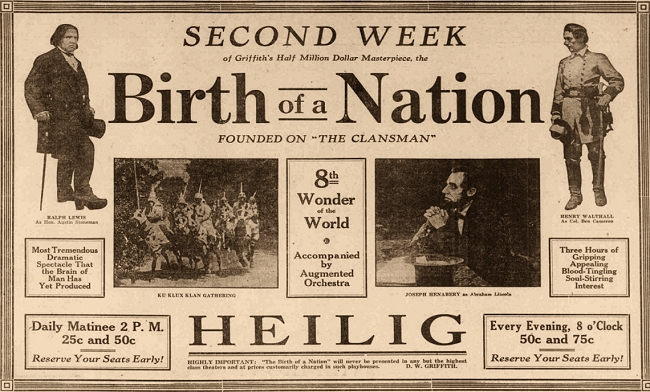
Lillian Gish portrayed the "Eternal Motherhood" tying all four stories together. A total of 36 actors had on screen credited roles in the picture and another 25 had non on screen credited roles.
On March 21, 2016, Film Historian and Scholar Frank Beaver wrote "A Century After Intolerance" for the "Regents of the University of Michigan"stating the following:
Griffith's intended message in Intolerance was not lost on reviewers.
Nine years after the release of "The Birth of a Nation", actress, Mary Pickford, was quoted, in the January 1924 issue of the magazine "Photoplay", saying of the film, by her co-founder of "United Artists Pictures":
Birth of a Nation was the first picture that really made people take the motion picture industry seriously.The controversy over racism forced America to take a dark look at itself in 1915 and as Mary Pickford stated. "The Birth of a Nation" also illustrated the power a motion picture could have on an audience. The medium was no longer a "Nickelodeon" novelty.
Fourteen years after "Intolerance" David Wark Griffith returned to the American Civil War and made:
ABRAHAM LINCOLN released August 25, 1930
_03.jpg)
The motion picture was co-produced and directed by Griffith. His co-producer was Joseph M. Schenck. Between 1917 and 1936 Russian born Schenck directly produced 77 feature films and between 1917 to 1936 was a "Producer and Presenter" of 133 other motion pictures including "Abraham Lincoln" for different studios including the Griffith, Pickford and Fairbanks Studio "United Artists".
The screen play was by American Poet and Short Story writer Stephen Vincent Benet. Benet is known for his long 1928 poem "John Brown's Body". For which he won the Pulitzer Prize. Benet is also known for the 1936 short story "The Devil and Daniel Webster".
John W. Considine, Jr. co-wrote the screenplay, but would be known as a producer for motion pictures such as Peter Lorre's 1935 "Mad Love", 1940's "Young Tom Edison" starring Mickey Rooney and its sequel "Edison the Man" starring Spencer Tracy.
Gerrit J. Lloyd wrote additional dialogue for this picture and 4 other D.W. Griffith films.
The role of "Abraham Lincoln" was portrayed by Walter Huston. This was Huston's 9th feature film including the 1929 Gary Cooper Western "The Virginian". In 1941 he had a small role in his son, John's, "The Maltese Falcon" and co-starred in John's 1948 "The Treasure of the Sierra Madre". Walter Huston's other work included 1932's "Rain" opposite Joan Crawford and 1942's "Yankee Doodle Dandy" as James Cagney's father.

Una Merkel portrayed Ann Ruthledge. Merkel once a stand in for Lillian Gish, became a classic motion picture comedian after this motion picture. Below she is with Huston in the first part of the feature.

Kay Hammond was Mary Todd Lincoln. Hammond only has 11 film roles to her credit and this is her one major performance. Below she is in "Ford's Theater" with Huston's Lincoln.

The shorter first part dealt with Lincoln becoming a lawyer and his early romance with Ann Ruthledge. The majority over the motion picture deals with the Civil War, his marriage to Mary Todd, and climaxes with Lincoln's assassination.


At the time of its release, "Variety", went straight to the fear that "Abraham Lincoln" would showcase Griffith's Southern Racial views and be a new "The Birth of a Nation", writing:
More than an outstanding classic of sound pictures, Abraham Lincoln eclipses the most conservative illusion of a modernized Birth of a Nation.The screenplay wasn't the inflammatory rhetoric of 1915, but a too sober look at the subject matter mainly by poet Stephen Benet.
Another aspect of this picture was the simple fact that this was the first Sound Motion Picture, about the Civil War, that living Veteran's of that War could view. One has to wonder what they thought though?
David Wark Griffith made one other sound motion picture, 1931's "The Struggle", but like "Abraham Lincoln", it had a poor box office. Both features were not what "Depression Era" America wanted to see. Griffith never made another film afterwards.
On July 23, 1948, in Hollywood, California, D.W. Griffith passed away from a cerebral hemorrhage.





